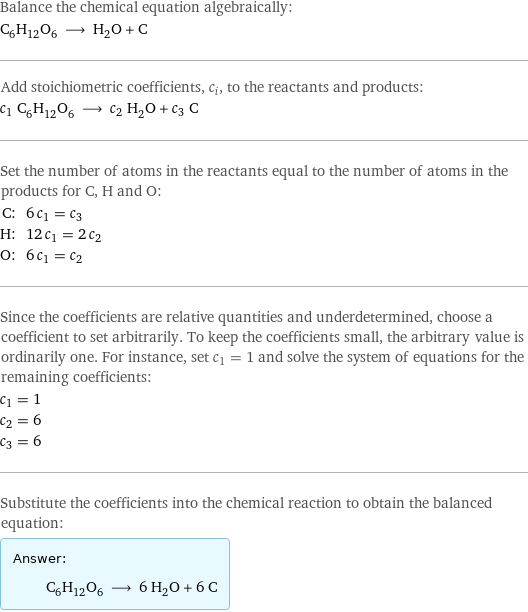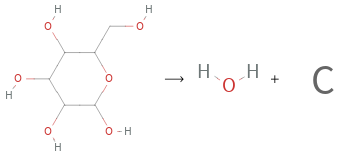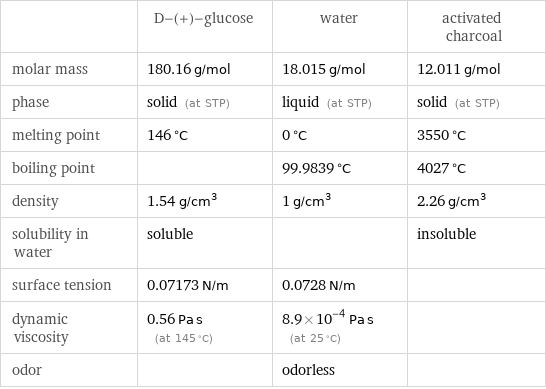Input interpretation

C_6H_12O_6 D-(+)-glucose ⟶ H_2O water + C activated charcoal
Balanced equation

Balance the chemical equation algebraically: C_6H_12O_6 ⟶ H_2O + C Add stoichiometric coefficients, c_i, to the reactants and products: c_1 C_6H_12O_6 ⟶ c_2 H_2O + c_3 C Set the number of atoms in the reactants equal to the number of atoms in the products for C, H and O: C: | 6 c_1 = c_3 H: | 12 c_1 = 2 c_2 O: | 6 c_1 = c_2 Since the coefficients are relative quantities and underdetermined, choose a coefficient to set arbitrarily. To keep the coefficients small, the arbitrary value is ordinarily one. For instance, set c_1 = 1 and solve the system of equations for the remaining coefficients: c_1 = 1 c_2 = 6 c_3 = 6 Substitute the coefficients into the chemical reaction to obtain the balanced equation: Answer: | | C_6H_12O_6 ⟶ 6 H_2O + 6 C
Structures

⟶ +
Names

D-(+)-glucose ⟶ water + activated charcoal
Equilibrium constant
![Construct the equilibrium constant, K, expression for: C_6H_12O_6 ⟶ H_2O + C Plan: • Balance the chemical equation. • Determine the stoichiometric numbers. • Assemble the activity expression for each chemical species. • Use the activity expressions to build the equilibrium constant expression. Write the balanced chemical equation: C_6H_12O_6 ⟶ 6 H_2O + 6 C Assign stoichiometric numbers, ν_i, using the stoichiometric coefficients, c_i, from the balanced chemical equation in the following manner: ν_i = -c_i for reactants and ν_i = c_i for products: chemical species | c_i | ν_i C_6H_12O_6 | 1 | -1 H_2O | 6 | 6 C | 6 | 6 Assemble the activity expressions accounting for the state of matter and ν_i: chemical species | c_i | ν_i | activity expression C_6H_12O_6 | 1 | -1 | ([C6H12O6])^(-1) H_2O | 6 | 6 | ([H2O])^6 C | 6 | 6 | ([C])^6 The equilibrium constant symbol in the concentration basis is: K_c Mulitply the activity expressions to arrive at the K_c expression: Answer: | | K_c = ([C6H12O6])^(-1) ([H2O])^6 ([C])^6 = (([H2O])^6 ([C])^6)/([C6H12O6])](../image_source/88a85182a5a69b8cab690f6208aacfb6.png)
Construct the equilibrium constant, K, expression for: C_6H_12O_6 ⟶ H_2O + C Plan: • Balance the chemical equation. • Determine the stoichiometric numbers. • Assemble the activity expression for each chemical species. • Use the activity expressions to build the equilibrium constant expression. Write the balanced chemical equation: C_6H_12O_6 ⟶ 6 H_2O + 6 C Assign stoichiometric numbers, ν_i, using the stoichiometric coefficients, c_i, from the balanced chemical equation in the following manner: ν_i = -c_i for reactants and ν_i = c_i for products: chemical species | c_i | ν_i C_6H_12O_6 | 1 | -1 H_2O | 6 | 6 C | 6 | 6 Assemble the activity expressions accounting for the state of matter and ν_i: chemical species | c_i | ν_i | activity expression C_6H_12O_6 | 1 | -1 | ([C6H12O6])^(-1) H_2O | 6 | 6 | ([H2O])^6 C | 6 | 6 | ([C])^6 The equilibrium constant symbol in the concentration basis is: K_c Mulitply the activity expressions to arrive at the K_c expression: Answer: | | K_c = ([C6H12O6])^(-1) ([H2O])^6 ([C])^6 = (([H2O])^6 ([C])^6)/([C6H12O6])
Rate of reaction
![Construct the rate of reaction expression for: C_6H_12O_6 ⟶ H_2O + C Plan: • Balance the chemical equation. • Determine the stoichiometric numbers. • Assemble the rate term for each chemical species. • Write the rate of reaction expression. Write the balanced chemical equation: C_6H_12O_6 ⟶ 6 H_2O + 6 C Assign stoichiometric numbers, ν_i, using the stoichiometric coefficients, c_i, from the balanced chemical equation in the following manner: ν_i = -c_i for reactants and ν_i = c_i for products: chemical species | c_i | ν_i C_6H_12O_6 | 1 | -1 H_2O | 6 | 6 C | 6 | 6 The rate term for each chemical species, B_i, is 1/ν_i(Δ[B_i])/(Δt) where [B_i] is the amount concentration and t is time: chemical species | c_i | ν_i | rate term C_6H_12O_6 | 1 | -1 | -(Δ[C6H12O6])/(Δt) H_2O | 6 | 6 | 1/6 (Δ[H2O])/(Δt) C | 6 | 6 | 1/6 (Δ[C])/(Δt) (for infinitesimal rate of change, replace Δ with d) Set the rate terms equal to each other to arrive at the rate expression: Answer: | | rate = -(Δ[C6H12O6])/(Δt) = 1/6 (Δ[H2O])/(Δt) = 1/6 (Δ[C])/(Δt) (assuming constant volume and no accumulation of intermediates or side products)](../image_source/f82e7f82a00dc829f9034aef261ed983.png)
Construct the rate of reaction expression for: C_6H_12O_6 ⟶ H_2O + C Plan: • Balance the chemical equation. • Determine the stoichiometric numbers. • Assemble the rate term for each chemical species. • Write the rate of reaction expression. Write the balanced chemical equation: C_6H_12O_6 ⟶ 6 H_2O + 6 C Assign stoichiometric numbers, ν_i, using the stoichiometric coefficients, c_i, from the balanced chemical equation in the following manner: ν_i = -c_i for reactants and ν_i = c_i for products: chemical species | c_i | ν_i C_6H_12O_6 | 1 | -1 H_2O | 6 | 6 C | 6 | 6 The rate term for each chemical species, B_i, is 1/ν_i(Δ[B_i])/(Δt) where [B_i] is the amount concentration and t is time: chemical species | c_i | ν_i | rate term C_6H_12O_6 | 1 | -1 | -(Δ[C6H12O6])/(Δt) H_2O | 6 | 6 | 1/6 (Δ[H2O])/(Δt) C | 6 | 6 | 1/6 (Δ[C])/(Δt) (for infinitesimal rate of change, replace Δ with d) Set the rate terms equal to each other to arrive at the rate expression: Answer: | | rate = -(Δ[C6H12O6])/(Δt) = 1/6 (Δ[H2O])/(Δt) = 1/6 (Δ[C])/(Δt) (assuming constant volume and no accumulation of intermediates or side products)
Chemical names and formulas

| D-(+)-glucose | water | activated charcoal formula | C_6H_12O_6 | H_2O | C name | D-(+)-glucose | water | activated charcoal IUPAC name | 6-(hydroxymethyl)oxane-2, 3, 4, 5-tetrol | water | carbon
Substance properties

| D-(+)-glucose | water | activated charcoal molar mass | 180.16 g/mol | 18.015 g/mol | 12.011 g/mol phase | solid (at STP) | liquid (at STP) | solid (at STP) melting point | 146 °C | 0 °C | 3550 °C boiling point | | 99.9839 °C | 4027 °C density | 1.54 g/cm^3 | 1 g/cm^3 | 2.26 g/cm^3 solubility in water | soluble | | insoluble surface tension | 0.07173 N/m | 0.0728 N/m | dynamic viscosity | 0.56 Pa s (at 145 °C) | 8.9×10^-4 Pa s (at 25 °C) | odor | | odorless |
Units
